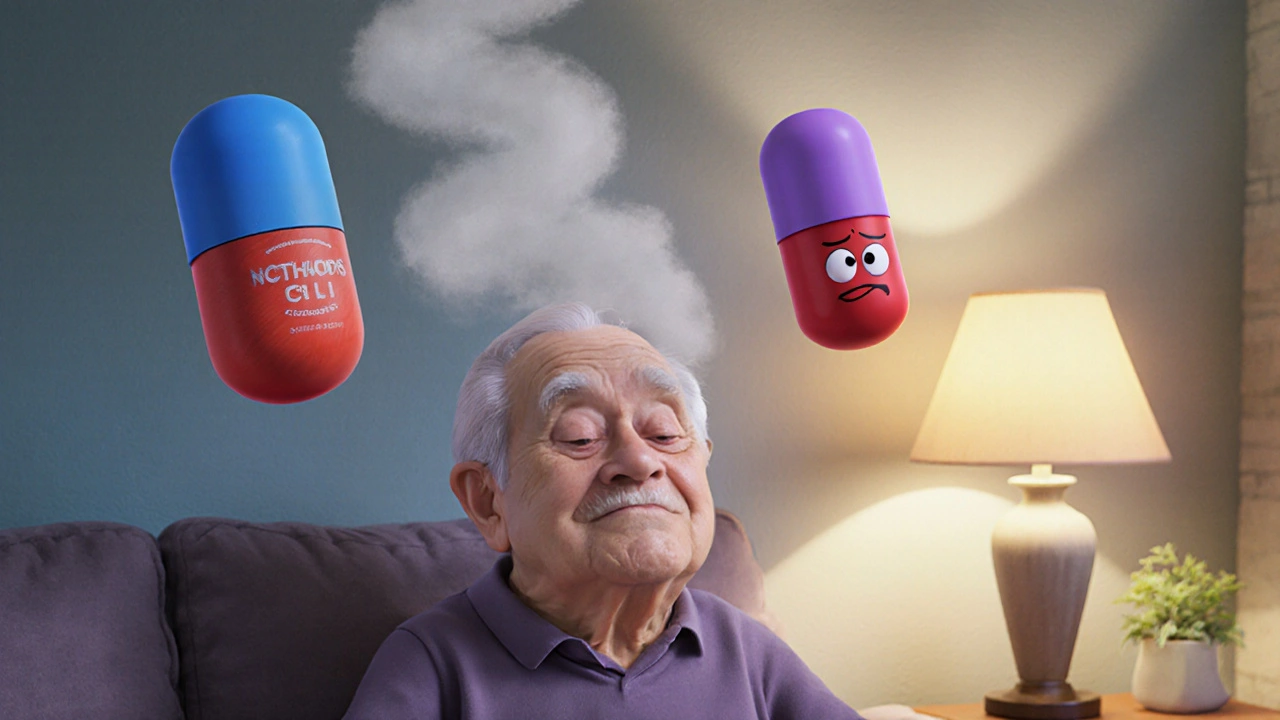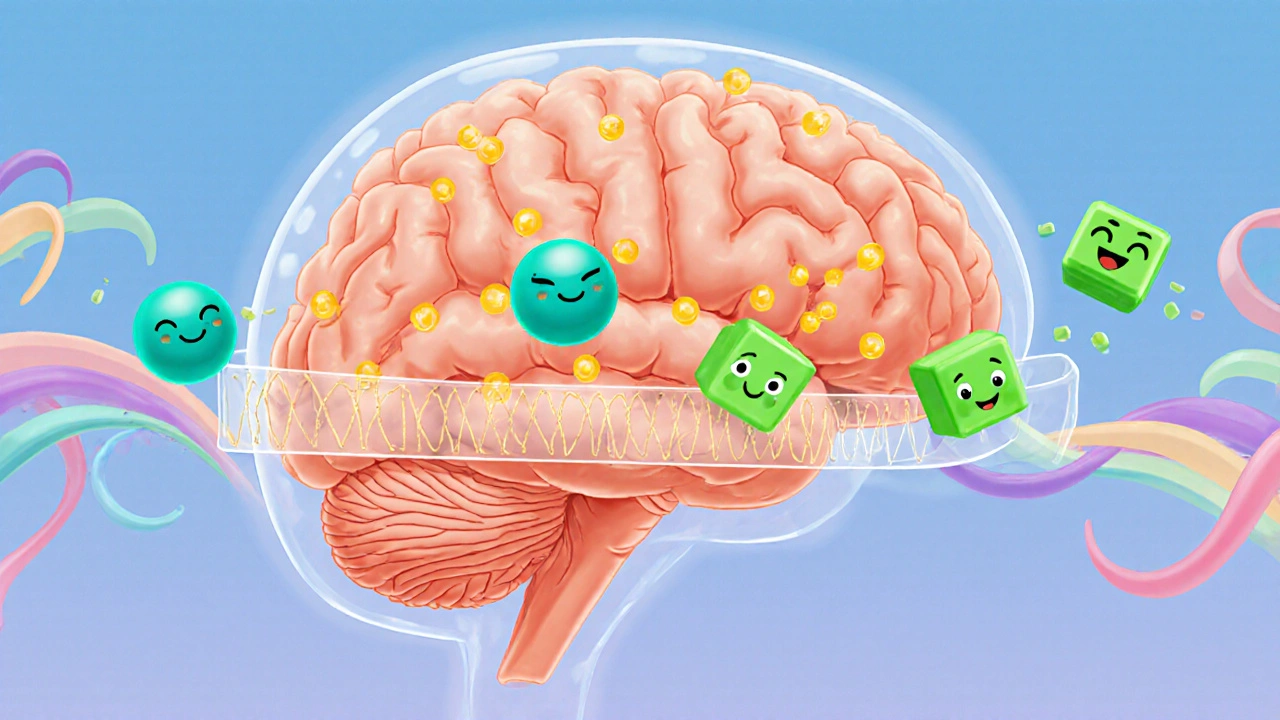Anticholinergic Burden Calculator
Anticholinergic Burden Assessment
Select medications you or your patient is currently taking. This tool calculates cumulative anticholinergic burden (ACB) score, which indicates risk of cognitive impairment and adverse events.
Results
Score < 2 indicates minimal anticholinergic burden. Continue monitoring but no immediate action needed.
Key Recommendations
For ACB scores < 3: Monitor for drowsiness and cognitive changes. Avoid alcohol and additional sedating medications.
For ACB scores ≥ 3: Consider replacing first-generation antihistamines with second-generation alternatives. Consult a pharmacist or physician.
When you mix an antihistamine a drug that blocks histamine receptors to relieve allergy symptoms with other depressants, the result can be more than just extra drowsiness. Below we break down why the combination matters, which drug pairings are the most hazardous, and how clinicians and patients can stay safe.
How Antihistamines Work in the Brain
First‑generation antihistamines such as diphenhydramine a classic over‑the‑counter sleep aid and allergy pill cross the blood‑brain barrier and block H1 receptors in the central nervous system (CNS). That blockade produces the well‑known sedation but also brings strong anticholinergic effects, which can impair memory and coordination. Second‑generation agents like loratadine a non‑sedating, daily allergy medication are pumped out of the brain by P‑glycoprotein transporters, so they stay mainly in the periphery and rarely cause CNS depression.
Why Sedating Medications Amplify the Effect
Drugs that already depress the CNS-benzodiazepines, opioids, certain antidepressants, and even alcohol-share a common pathway: they enhance the activity of GABA or blunt excitatory neurotransmitters. Adding a first‑generation antihistamine adds another layer of inhibition, often by the same GABA‑related mechanisms, resulting in synergistic sedation, respiratory depression, or profound cognitive impairment.
Research published in the Journal of Investigational Allergology & Clinical Immunology (2013) showed that diphenhydramine boosted lorazepam’s sedative impact by 37% in objective testing and raised subjective drowsiness scores by 42%. The interaction is not merely additive; it’s multiplicative, especially in people whose liver metabolism is already slowed.
First‑Generation vs. Second‑Generation Risks
| Factor | First‑Generation Antihistamines | Second‑Generation Antihistamines |
|---|---|---|
| CNS Penetration | High - crosses blood‑brain barrier | Low - limited brain entry |
| Anticholinergic Burden (ACB score) | 2-3 (high) | 0-1 (minimal) |
| Interaction with Benzodiazepines | Significant increase in sedation (≈40%) | Negligible |
| Interaction with Opioids | Respiratory depression risk rises from 1.5% to ~8.7% | No measurable effect |
| Common Use Cases | Night‑time allergy relief, motion sickness, short‑term sleep aid | Daytime allergy control, chronic rhinitis |
The table makes it clear why clinicians now start most patients on loratadine, cetirizine, or fexofenadine rather than Benadryl, especially when the patient already takes a sedating drug.

High‑Risk Drug Pairings
Below are the most frequently flagged combos, why they matter, and what the data say.
- Benzodiazepines + diphenhydramine: Increases risk of falls and motor vehicle accidents. CDC data (2022) attribute an 8.7% rise in respiratory events when opioids or benzodiazepines are paired with first‑gen antihistamines.
- Opioids + diphenhydramine or hydroxyzine: Amplifies respiratory depression; emergency department visits rise dramatically (14.7% of CNS‑depressant‑related ADRs involve antihistamines). \n
- Alcohol + any first‑gen antihistamine: Even one standard drink can push a 25 mg diphenhydramine dose into a blackout‑level sedation, as reported by multiple Reddit r/Pharmacy users.
- Cimetidine (H2 blocker) + antihistamines metabolized by CYP3A4: Cimetidine inhibits CYP enzymes by up to 70%, raising plasma levels of diphenhydramine and potentially leading to toxicity.
- Anticholinergic drugs (e.g., oxybutynin) + first‑gen antihistamines: In older adults, the combo spikes delirium risk by more than 50% (JAMA Intern Med, 2021).
Special Populations: The Elderly and Polypharmacy
Age brings slower liver clearance and a higher baseline anticholinergic load. A typical Medicare beneficiary now takes about 7.8 prescription meds, many of which carry an ACB score of 1 or higher. Adding diphenhydramine, which scores 3, can push the total burden past the threshold associated with cognitive decline and increased dementia risk (Gray et al., 2015).
Practical guidance:
- Run an anticholinergic burden calculator (University of Washington offers a free tool) for every patient over 65.
- If the cumulative ACB score reaches 3 or more, replace first‑gen antihistamines with a second‑generation alternative.
- Set up electronic alerts for high‑risk pairings; Kaiser Permanente’s alert system cut antihistamine‑related adverse events by 34%.

How to Manage Interactions in Real‑World Settings
When a patient needs an antihistamine but is already on a sedating drug, follow a stepwise approach.
- Assess necessity. Is the antihistamine required for acute symptoms (e.g., hives) or can a non‑pharmacological measure suffice?
- Choose the safest option. Opt for a second‑generation agent; even cetirizine, which has a low ACB score of 1, is preferable to diphenhydramine.
- Adjust timing. Separate dosing by at least 4-6 hours when a sedating antihistamine must be used with a benzodiazepine (e.g., bedtime diphenhydramine after an afternoon lorazepam).
- Monitor closely. Look for signs of excessive drowsiness, slowed breathing, or confusion, especially in the first 24 hours.
- Educate the patient. Explain that “non‑drowsy” does not always mean “no interaction” and that alcohol should be avoided.
Pharmacogenomic testing is emerging as a useful adjunct. Poor CYP2D6 metabolizers can see diphenhydramine levels rise 3‑fold, making any sedating combination far riskier (Nature Medicine, 2024).
Future Directions
Third‑generation antihistamines such as levocetirizine and bilastine are being fine‑tuned to eliminate CNS entry completely. Early trials suggest bilastine has no measurable impact on lorazepam‑induced sedation, even at high doses. As labeling becomes stricter-FDA now requires bold warnings on diphenhydramine packaging-the market share of first‑generation agents is projected to dip below 20% by 2028.
Meanwhile, clinicians are urged to incorporate routine drug interaction checks into every prescription workflow. Simple steps-using a free online antihistamine interaction checker, flagging high‑risk combos in the EMR, and discussing anticholinergic load with patients-can dramatically reduce the 2.1 million annual emergency visits tied to CNS depressant interactions.
Quick Reference Checklist
- Identify if the antihistamine is first‑ or second‑generation.
- Check the patient’s anticholinergic burden (target < 3).
- Review co‑prescribed CNS depressants: benzodiazepines, opioids, sleep aids, alcohol.
- Prefer non‑sedating agents for chronic allergy control.
- Document counseling on interaction risks and timing adjustments.
Can I safely take Benadryl with my prescribed sleep medication?
Generally no. Benadryl (diphenhydramine) adds a strong anticholinergic load and amplifies the sedative effect of most sleep meds, increasing fall risk. If you need an antihistamine at night, ask your doctor about a short‑term switch to a second‑generation option like cetirizine, which carries far less sedation.
Do second‑generation antihistamines interact with opioids?
Studies show negligible interaction. Drugs like loratadine and fexofenadine stay out of the brain and do not raise opioid‑related respiratory depression. However, always check the specific product label for rare metabolism issues.
What is the Anticholinergic Cognitive Burden (ACB) score?
The ACB score rates a drug’s anticholinergic activity from 0 (none) to 3 (high). Scores of 2 or 3 are linked to memory problems and higher dementia risk, especially when multiple such drugs are used together.
Is it okay to combine diphenhydramine with alcohol at a social event?
Even a single drink can push the combination into dangerous sedation. Reports from Reddit and GoodRx show blackout‑level drowsiness and breathing slowdowns. Best practice: skip the antihistamine or the alcohol.
How can I check my total anticholinergic load?
Use the University of Washington Anticholinergic Burden Calculator. Enter each prescription and over‑the‑counter drug; the tool sums ACB scores and flags high‑risk totals.


sarah basarya
October 26, 2025 AT 16:39So you think you can just mix Benadryl with your night-time Xanax and hope for the best? Newsflash: the brain doesn't care about your convenience. First-gen antihistamines slam the CNS like a sledgehammer, and when you add a benzodiazepine you’re basically inviting a blackout. The CDC stats aren't just numbers; they're a red flag for falls and fatal respiratory events. Bottom line: ditch the diphenhydramine unless you want a one‑way ticket to the ER.
Leah Ackerson
November 2, 2025 AT 15:19🧐 Philosophically speaking, the sedative synergy is a tragic comedy of errors-your body becomes a stage where GABA and anticholinergic forces perform a duet of drowsiness. The irony is delicious: you chase relief and end up courting danger. 🙃 If you must, schedule the antihistamine hours apart and keep the lights on. Remember, the night is long enough without an extra fog clouding it.
abidemi adekitan
November 9, 2025 AT 13:59Let me walk you through why the interaction between first‑generation antihistamines and CNS depressants is more than a simple additive effect.
When diphenhydramine crosses the blood‑brain barrier it binds to H1 receptors, dampening histaminergic wakefulness while simultaneously exerting anticholinergic torque on muscarinic pathways.
At the same time, benzodiazepines like lorazepam amplify GABA‑A receptor opening, pulling the neuronal firing rate down to a crawl.
Now picture these two mechanisms colliding in the same neuronal micro‑environment – the result is a multiplicative slowdown that can halve reaction times and double the odds of respiratory compromise.
Clinical data from the 2013 Journal of Investigational Allergology study shows a 37 % increase in objective sedation scores, and patients report feeling as though the world has turned into a slow‑motion movie.
In older adults, the anticholinergic burden score jumps dramatically, pushing many over the threshold associated with delirium and accelerated cognitive decline.
The liver’s cytochrome P450 enzymes become bottlenecks when metabolism is already sluggish, leading to higher plasma concentrations of both drugs.
Pharmacogenomic testing can reveal poor CYP2D6 metabolizers who experience three‑fold rises in diphenhydramine levels, magnifying every sedative effect.
From a safety standpoint, electronic health record alerts have demonstrated a 34 % reduction in adverse events when they flag these high‑risk pairings.
In practice, a simple stepwise approach-assess necessity, choose a second‑generation agent, separate dosing by four to six hours, and monitor the patient-can mitigate most of the danger.
If a patient insists on an antihistamine for acute hives, short‑acting diphenhydramine at the lowest effective dose may be acceptable, but only under close observation.
Otherwise, swapping to loratadine or cetirizine eliminates most CNS penetration while still providing symptom relief.
The upcoming third‑generation antihistamines, such as bilastine, are engineered to stay out of the brain entirely, promising a future where this interaction becomes a relic of the past.
Until then, education remains key: patients must understand that “non‑drowsy” does not equal “no interaction,” especially when alcohol is on the table.
So, in summary, treat every antihistamine–depressant combo as a red‑flag scenario and act accordingly.
Barbara Ventura
November 16, 2025 AT 12:39Wow, the data is crystal clear, the risks are undeniable, and the recommendations are straightforward, so why keep mixing these drugs?!
laura balfour
November 23, 2025 AT 11:19Honestly, staring at that table feels like looking at a battlefield-first‑gen antihistamines are the heavy artillery, while second‑gen are the snipers, precise and far less noisy. The numbers don’t lie, an 8.7% jump in respiratory events is huge, and the elderly are the most vulnerable. I’ve seen patients wobble off the stairs after a night of Benadryl and a little oxycodone; it’s a horror story you don’t want to read in a textbook. The anticholinergic load, as the article nicely points out, can push dementia risk over the edge, and that’s not a minor footnote. If you’re prescribing, think twice, maybe even thrice, before you slap that diphenhydramine on the chart. Trust me, a non‑sedating alternative will save you and your patient a lot of grief.
Ramesh Kumar
November 30, 2025 AT 09:59For clarity, the pharmacokinetic interaction is largely mediated by CYP3A4 inhibition; diphenhydramine is metabolized partially by this pathway, so co‑administration with strong inhibitors can raise its AUC by up to 70 %. Additionally, benzodiazepines increase GABAergic tone, which, when combined with antihistamine‑induced H1 blockade, creates a synergistic sedative effect. The CDC’s 2022 data indeed show an 8.7 % rise in respiratory adverse events in such combos. Using tools like the UW Anticholinergic Burden Calculator gives a quick snapshot of cumulative ACB scores. In practice, switching to a second‑generation agent eliminates most of these concerns.
asha aurell
December 7, 2025 AT 08:39Mixing Benadryl with a sleep aid is a recipe for dangerous oversedation.